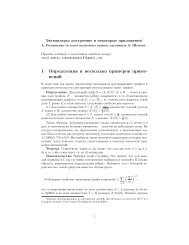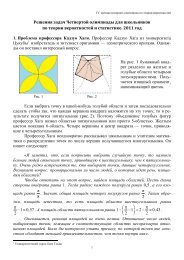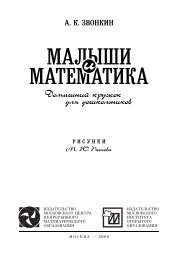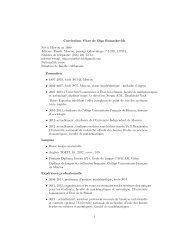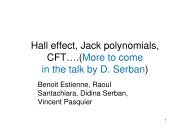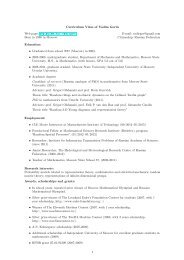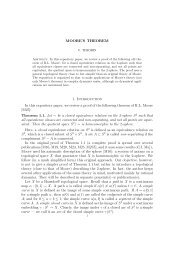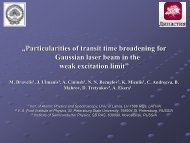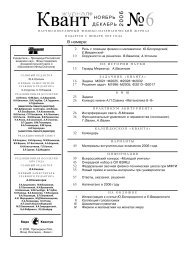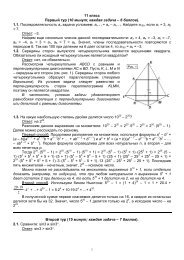a gauss-bonnet theorem, chern classes and an adjunction formula
a gauss-bonnet theorem, chern classes and an adjunction formula
a gauss-bonnet theorem, chern classes and an adjunction formula
You also want an ePaper? Increase the reach of your titles
YUMPU automatically turns print PDFs into web optimized ePapers that Google loves.
9<br />
a smooth complex variety X one c<strong>an</strong> define the following geometric invari<strong>an</strong>ts: the<br />
global Euler characteristic χ(X, F) <strong><strong>an</strong>d</strong> the characteristic cycle CC(F).<br />
The global Euler characteristic χ(X, F) is defined as the the Euler characteristic<br />
of the complex of cohomology groups H i (X, F). The latter are obtained by taking<br />
the derived functor of global sections of F (see [21]).<br />
There exists a morphism from the derived category of constructible complexes on a<br />
smooth complex variety X to the group of Lagr<strong>an</strong>gi<strong>an</strong> cycles in the cot<strong>an</strong>gent bundle<br />
T ∗ X (see [21] Section 9.4). It has nice functorial properties. The characteristic cycle<br />
CC(F) of a constructible complex F is the image of F under this morphism.<br />
A constructible complex F on X is called a perverse sheaf if it satisfies the following<br />
two conditions. First, the local cohomology H i (F x ) are supported on a subset of<br />
dimension at most −i. Second, the local cohomology H i c(F x ) with compact support<br />
are supported on a subset of dimension at most i ([21, 18, 31]).<br />
We now <strong>formula</strong>te the main results. Let G be a complex reductive group, <strong><strong>an</strong>d</strong><br />
let F be a constructible complex on G.<br />
The characteristic cycle of F is a linear<br />
combination of Lagr<strong>an</strong>gi<strong>an</strong> subvarieties CC(F) = ∑ c α T ∗ X α<br />
G. Here <strong><strong>an</strong>d</strong> in the sequel<br />
T ∗ XG denotes the closure of the conormal bundle to the smooth locus of a subvariety<br />
X ⊂ G. With X one c<strong>an</strong> associate a nonnegative number gdeg(X) called the Gaussi<strong>an</strong><br />
degree of X. It is equal to the number of zeros of a generic left-invari<strong>an</strong>t differential<br />
1-form on G restricted to X. The precise definitions of the Gaussi<strong>an</strong> degree <strong><strong>an</strong>d</strong> of<br />
the Gauss map are given in section 2.2.<br />
Theorem 2.1. If F is equivari<strong>an</strong>t under the adjoint action of G, then its Euler<br />
characteristic c<strong>an</strong> be computed in terms of the characteristic cycle by the following<br />
<strong>formula</strong><br />
χ(G, F) = ∑ c α gdeg(X α ).<br />
For a perverse sheaf the multiplicities c α of its characteristic cycle are nonnegative




